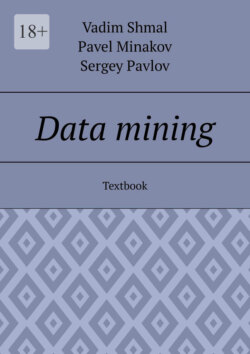Читать книгу Data mining. Textbook - Vadim Shmal - Страница 2
Data mining
ОглавлениеData mining is the process of extracting and discovering patterns in large datasets using methods at the interface of machine learning, statistics, and database systems, especially databases containing large numerical values. This includes searching large amounts of information for statistically significant patterns using complex mathematical algorithms. Collected variables include the value of the input data, the confidence level and frequency of the hypothesis, and the probability of finding a random sample. It also includes optimizing the parameters to get the best pattern or result, adjusting the input based on some facts to improve the final result. These parameters include parameters for statistical means such as sample sizes, as well as statistical measures such as error rate and statistical significance.
The ideal scenario for data mining is that the parameters are in order, which provides the best statistical results with the most likely success values. In this ideal scenario, data mining takes place within a closed mathematical system that collects all inputs to the system and produces the most likely outcome. In fact, the ideal scenario is rarely found in real systems. For example, in real life this does not happen when engineering estimates for a real design project are received. Instead, many factors are used to calculate the best measure of success, such as project parameters and the current difficulty of bringing the project to the project specifications, and these parameters are constantly changing as the project progresses. While they may be useful in certain situations, such as the development of specific products, their values should be subject to constant re-evaluation depending on the current conditions of the project. In fact, the best data analysis happens in a complex mathematical structure of problems with many variables and many constraints, and not in a closed mathematical system with only a few variables and a closed mathematical structure.
Data is often collected from many different sources and several different directions. Each type of data is analyzed and all of that output is analyzed to get an estimate of how each piece of data may or may not be involved in the final result. Such analysis is often referred to as the analysis process or data analysis. Data analysis also includes identifying other important information about the database that may or may not have a direct impact on the results. Often, they are also generated from different sources.
Data is usually collected from many different sources and many statistical methods are applied to obtain the best statistical results. The results of these methods are often referred to as statistical properties or parameters, and often define mathematical formulas that are intended for the results of each mathematical model. Mathematical formulas are often the most important aspects of the data analysis process and are usually structured using mathematical formulas known as algorithms. Some mathematical algorithms are based on some theoretical approach or model. Other mathematical algorithms use logic and logical proofs as mathematical tools to understand data. Other mathematical algorithms often use computational procedures such as mathematical modeling and mathematical tools to understand a particular problem or data. While such computational procedures may be necessary to complete a mathematical model of the data, such mathematical algorithms may have other mathematical tools that may be more appropriate for the real world. Although these mathematical models are often very complex, it is often easier to develop a mathematical algorithm and model from a mathematical model than to develop a mathematical algorithm and model from an actual data analysis process.
In reality, there are usually a number of mathematical models that provide a more complete understanding of the situation and data than any one mathematical model or mathematical algorithm. The data is then analyzed and a mathematical model of the data is often used to derive a specific parameter value. This parameter value is usually determined by numerical calculations. If a parameter does not have a direct relationship with the result of the final analysis, the parameter is sometimes calculated indirectly using a statistical procedure that yields a parameter that has a direct correlation with the result of the data analysis. If a parameter has a direct correlation with the result of the data analysis, this parameter is often used directly to obtain the final result of the analysis. If the parameter is not directly related to the result of the analysis, the parameter is often obtained indirectly using a mathematical algorithm or model. For example, if data analysis can be described by a mathematical model, then a parameter can be obtained indirectly using a mathematical algorithm or model. It is usually easier to get the parameter directly or indirectly using a mathematical algorithm or model.
By collecting and analyzing many different kinds of data, and performing mathematical analysis on the data, the data can be analyzed and statistics and other statistical tools can be used to produce results. In many cases, the use of numerical calculations to obtain real data can be very effective. However, this process usually requires real-world testing before data analysis.
